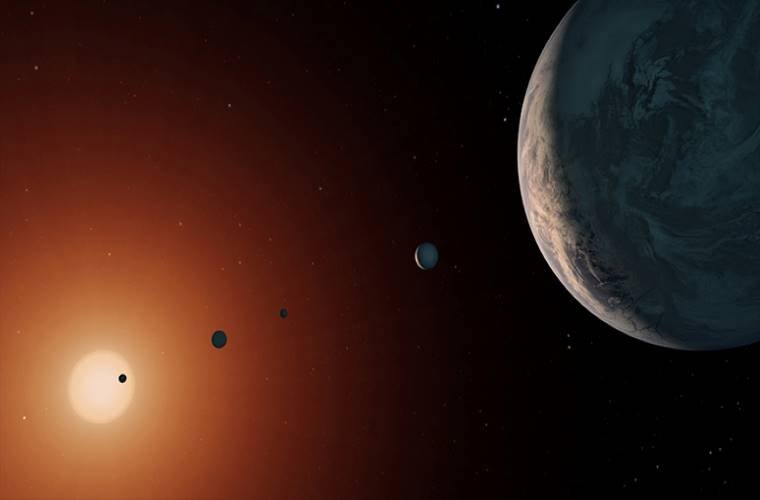The orbital harmony of the seven exoplanets spotted in the TRAPPIST-1 star system may indicate that they endured significantly fewer impact events after their original formation than our own solar system. This less hostile formation environment may have increased the chances for life, but may have also limited the accumulation of water and other key life-sustaining compounds found on Earth.
BACKGROUND: TRAPPIST-1 AND THE SEARCH FOR LIFE
The star TRAPPIST-1 is about 40 light years away, and is host to at least seven planets, labeled TRAPPIST-1b through TRAPPIST-1h. Based on current readings, a number of these exoplanets are potentially habitable, Earth-sized rocky worlds, making them tantalizing targets for astronomers, astrophysicists and astrobiologists alike who are hoping to find signs of extraterrestrial life outside of our own solar system.
The much anticipated James Webb Telescope, which is scheduled to be launched in December of 2021, should allow many of these alien life hunters the rare ability to measure the chemical composition of those and other exoplanetary atmospheres. Until then, researchers have continued to analyze the data already available about the TRAPPIST-1 system, and this latest analysis appears to have significant potential impacts on the search for life on those planets.


ANALYSIS: ORBITAL HARMONY AND HABITABILITY
In their recently published work, astrophysicist Sean Raymond from the University of Bordeaux in France and colleagues from Rice University’s CLEVER planets project (which is funded by NASA), looked at the unique orbital harmony of the seven exoplanets known to orbit TRAPPIST-1. Specifically, they hoped to determine how that mathematically precise orbit may have affected the habitability of these alien worlds.
“After rocky planets form, things bash into them,” said Raymond. “It’s called bombardment, or late accretion, and we care about it, in part, because these impacts can be an important source of water and volatile elements that foster life.”
Due to the unique orbital harmony of the TRAPPIST-1 system, which the press release announcing the study explains as “for every eight “years” on planet b, five pass on planet c, three on planet d, two on planet e and so on,” the team believes that those planets must have formed very early in the system’s development, likely 10 times faster than Earth. This combination of early formation and low bombardment means that the system may have been stable for a long enough time to support life.
“We can’t say exactly how much stuff bashed into any of these planets, but because of this special resonant configuration, we can put an upper limit on it,” said Raymond. “We can say, ‘It can’t have been more than this.’ And it turns out that that upper limit is actually fairly small.”
“We figured out that after these planets formed, they weren’t bombarded by more than a very small amount of stuff,” he added. “That’s kind of cool. It’s interesting information when we’re thinking about other aspects of the planets in the system.”
The research team also notes that much of the water and other life supporting elements found on Earth arrived during impact events well after the planet itself was formed. One such impact event caused a large enough chunk of Earth to break off that it formed the Moon. Therefore, this stable harmony may also mean that the rocky exoplanets spotted orbiting TRAPPIST-1 may not have the right elemental mix to support life.
“If a planet forms early and it is too small, like the mass of the moon or Mars, it cannot accrete a lot of gas from the disk,” said study co-author and Rice Professor of Earth Systems Science Rajdeep Dasgupta. “Such a planet also has much less opportunity to gain life-essential volatile elements through late bombardments.”
OUTLOOK: JAMES WEBB MAY SOLVE THE habitability PUZZLE
Like much of the research community looking for signs of life outside of our solar system, the team behind this study is looking forward to the launching of the James Webb Telescope (JWT), which is currently slated for December 22nd of this year.
“We have some constraints today on the composition of these planets, like how much water they can have,” said Rice researcher and post-doctoral fellow Andre Izidoro regarding planets that form in a resonant, migration phase. “But we have very big error bars.”
Measurements of these planet’s atmospheres by the JWT could significantly improve their models, say researchers, which would aid future missions trying to pinpoint which is the most likely TRAPPIST-1 exoplanet to look for life.
“For instance, if one of these planets has a lot of water, let’s say 20% mass fraction, the water must have been incorporated into the planets early, during the gaseous phase,” said Izidoro. “So you will have to understand what kind of process could bring this water to this planet.”
“For the TRAPPIST-1 system, we have these Earth-mass planets that formed early,” concluded Izidoro. “So one potential difference, compared to the Earth’s formation, is that they could have, from the beginning, some hydrogen atmosphere and have never experienced a late giant impact. And this might change a lot of the evolution in terms of the interior of the planet, outgassing, volatile loss and other things that have implications for habitability.”
Follow and connect with author Christopher Plain on Twitter: @plain_fiction

